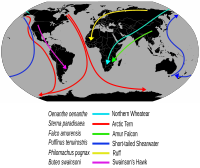
Photo from wikipedia
Abstract Every spring a huge number of passerines cross the Sahara Desert and the Mediterranean Sea on their way to their breeding grounds. Stopover sites after such extended barriers where… Click to show full abstract
Abstract Every spring a huge number of passerines cross the Sahara Desert and the Mediterranean Sea on their way to their breeding grounds. Stopover sites after such extended barriers where birds can rest, refuel, and find shelter from adverse weather, are of crucial importance for the outcome of their migration. Stopover habitat selection used by migrating birds depends on landscape context, habitat patch characteristics, as well as on the particular energetic conditions and needs of individual birds, but it is still poorly investigated. We focused on a long-distance migrating passerine, the woodchat shrike, in order to investigate for the first time the species’ habitat selection at a spring stopover site (island of Antikythira, Greece) after the crossing of the Sahara Desert and Mediterranean Sea. We implemented radio-tracking, color-ringing, and visual behavioral observations to collect data on microhabitat use. Generalized Linear Mixed Models were developed to identify the species’ most preferred microhabitat during its stopover on this low human disturbed island. We found that high maquis vegetation surrounded by low vegetation was chosen as perches for hunting. Moreover, high maquis vegetation appeared to facilitate hunting attempts toward the ground, the most frequently observed foraging strategy. Finally, we discuss our findings in the context of conservation practices for the woodchat shrike and their stopover sites on Mediterranean islands.
Journal Title: Current Zoology
Year Published: 2017
Link to full text (if available)
Share on Social Media: Sign Up to like & get
recommendations!